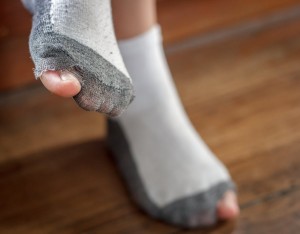Interview is to Job Offer as Clothing is to First Impression?

I ask this question because of a recent observation: While in Barnes & Noble, I noticed a gentleman seated across from me conducting job interviews. At first I wasn’t aware that this event was taking place. You see, the first person who sat down to talk with the man was dressed in torn jeans and a t-shirt. Her hair was sloppily all over her head and she wore sneakers.
From the conversation—the man talked casually and asked when she could start—I assumed the two were meeting to briefly discuss a previous job offer, not an interview.
Yet, after another young man—surprisingly dressed similar to the first girl—approached the guy to talk, I soon realized interviews were taking place.
I had automatically assumed these were just casual conversations because the interviewees did not “look” like they were going on an interview. Yet, after thinking about it, neither did the interviewer. He also dressed casually (although more professional looking than the interviewees).
This led me to wonder about the do’s and don’ts of interview attire. We’ve received so much information about what is and what is not acceptable and professional interview attire, but are the rules changing? Should an interviewee dress for the role?
Take the Barnes & Noble example:
The interviews were for a job that helped with children’s gaming parties. The interviewer owned a gamers party bus where people would rent the bus for X amount of hours (usually children’s parties) and inside the vehicle were X amount of video games and technology for the kids to enjoy.
From my I’m-not-eavesdropping seat, I understood that the role would help setup and tear down for different parties; would be flexible because it was dependent on when parties were scheduled; would require a lot of movement and interaction with children; and was starting at part-time because the summer months were the busiest, yet business slowed as the seasons changed.
This, obviously, was not an office, 9am-5pm job where workers would need to dress in business causal or professional attire. This was a casual, fun and active role, so it would make sense for the interviewees to show up looking the part, right?
Should interview attire be dependent upon the role? Or should job seekers stick with business casual and the set standards of professional attire?
Some employment reports say it should be dependent upon the role. Take this Robert Half Technology survey, for example, which found that one-third (33 per cent) of CIOs believe a business suit is the most appropriate attire for someone interviewing for an IT position. Another 29 percent of respondents favored tailored separates, while an additional 29 percent said they prefer khakis and a collared shirt.
The following results were taken after CIOs were asked, “Which of the following, in your opinion, is the most appropriate interview attire for someone interviewing for an IT job with your company?”
- Formal business suit (33%)
- Tailored separates (for example, a skirt and blouse) (29%)
- Khakis and a collared shirt (29%)
- Jeans and a polo shirt (7%)
- Something else/don’t know (1%)
Yet, others may note that clothing reflects an individual and can make or break his or her chances of leaving a lasting impression when interviewing.
A study published by Psychology Today’s UK and Turkey team revealed how clothing very subtly influences other’s impressions of people.
“Our clothes make a huge difference to what people think about us – and without us knowing or in ways we couldn’t even imagine,” the story says. “People make their assessments in the first few seconds of seeing another; assessments that go way beyond how well you are dressed and how neat and tidy you might look.”
The Psychology Today study included more than 300 adults (men and women), who all looked at images of a man and a woman for just 3 seconds before making “snap judgements” about the people in the photos.
In some of the pictures the man wore a made-to-measure suit. In others he wore a very similar off-the-peg suit bought on the high street. The differences in the suits were very minor – we controlled for all the big differences such as color and fabric, as well as making sure the face of the model was pixillated so that there could be no hidden messages in the facial expressions.
The story reveals that after just a 3-second exposure, people judged the man wearing the bespoke suit more favorably—and the judgments were not about his attire.
They rated him as more confident, successful, flexible and a higher earner in a tailor-made suit than when he wore a high street equivalent. Since the model’s face in the pictures was blanked out these impressions must have been formed after quickly eyeing what he was wearing.
We can be honest: It’s very easy for us to quickly make an assumption about others based on their appearance. If a job seeker walked into an interview with spiked hair, a tattoo on his/her forehead and multiple piercings, the interviewer would have a totally different impression than if the same person walked in wearing a suit, hair neatly in a bun or cut with no signs of tattoos or piercings.
So, if clothing has such an immense influence on how we’re perceived, is it better to “play it safe” and stick with business casual when interviewing, no matter the role? Or should our current ‘professional standard’ be re-written and a job seeker be permitted to dress for the role without penalty?

